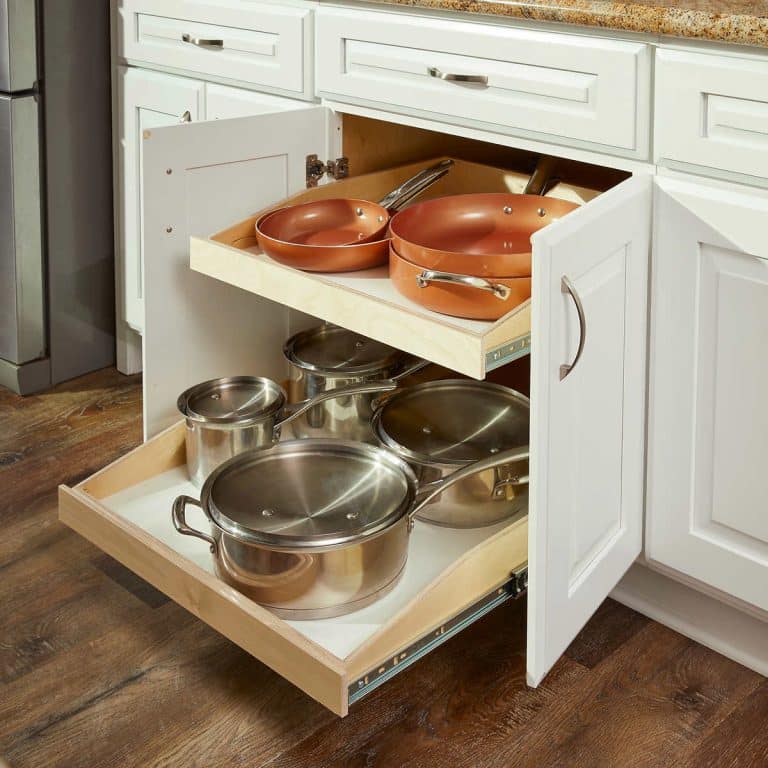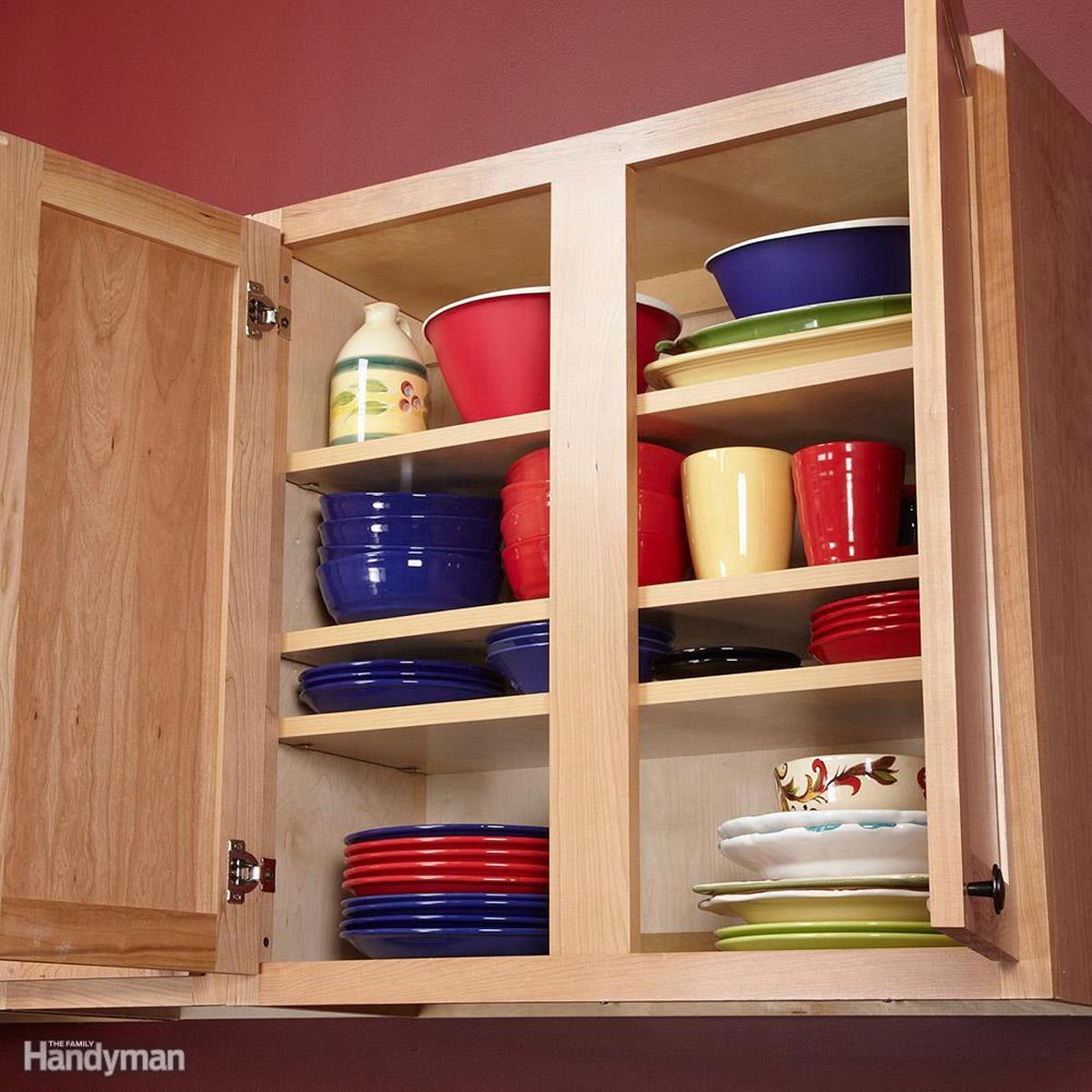Types of Extra Shelves

Adding extra shelves to your kitchen cabinets can significantly increase storage space and help you organize your kitchen more efficiently. There are many different types of extra shelves available, each with its own advantages and disadvantages. This section will explore the different types of shelves, their materials, construction, installation methods, and their respective benefits and drawbacks.
Wire Shelves
Wire shelves are a popular choice for kitchen cabinets due to their affordability and durability. They are typically made from steel, which is coated with a protective finish to prevent rust. Wire shelves are often used in pantry cabinets, under-sink cabinets, and other areas where ventilation is important.
- Advantages:
- Affordable: Wire shelves are generally less expensive than other types of shelves.
- Durable: Steel wire shelves are strong and can support a significant amount of weight.
- Ventilated: The open design of wire shelves allows for good air circulation, which helps to prevent moisture buildup and mildew.
- Easy to clean: Wire shelves are easy to wipe clean with a damp cloth.
- Disadvantages:
- Less aesthetically pleasing: Wire shelves can be less aesthetically pleasing than other types of shelves, particularly in cabinets with glass doors.
- Items can fall through: Small items can fall through the gaps in wire shelves.
Wood Shelves
Wood shelves are a more traditional choice for kitchen cabinets. They are often made from hardwoods like maple, oak, or cherry, which are known for their durability and beauty. Wood shelves can be stained or painted to match the existing décor of your kitchen.
- Advantages:
- Aesthetically pleasing: Wood shelves can add a touch of elegance to your kitchen.
- Durable: Hardwoods are strong and can withstand heavy items.
- Customizable: Wood shelves can be customized to fit any size or shape of cabinet.
- Disadvantages:
- More expensive: Wood shelves are generally more expensive than wire shelves.
- Prone to moisture damage: Wood can be susceptible to moisture damage, so it is important to use a sealant or finish to protect it.
- Difficult to clean: Wood shelves can be more difficult to clean than wire shelves.
Pull-Out Shelves
Pull-out shelves are a great way to maximize storage space in your kitchen cabinets. They are typically mounted on slides that allow them to be pulled out of the cabinet for easy access. Pull-out shelves are available in a variety of materials, including wire, wood, and metal.
- Advantages:
- Easy access: Pull-out shelves make it easy to reach items that are stored in the back of the cabinet.
- Increased storage space: Pull-out shelves can help to maximize the storage space in your cabinets.
- Variety of materials: Pull-out shelves are available in a variety of materials to match your kitchen décor.
- Disadvantages:
- More expensive: Pull-out shelves are generally more expensive than other types of shelves.
- Installation can be complex: Installing pull-out shelves can be more complex than installing other types of shelves.
Benefits of Extra Shelves

Adding extra shelves to your kitchen cabinets can significantly enhance organization and efficiency, making your culinary space more functional and enjoyable. Extra shelves create vertical storage, maximizing the use of available space and reducing clutter.
Maximizing Storage Space
Extra shelves allow for better utilization of vertical space, transforming unused areas into valuable storage zones. This can significantly reduce countertop clutter and create a more organized and efficient kitchen. Here are some tips for maximizing storage space with extra shelves:
- Store frequently used items on lower shelves: This ensures easy access and saves time when preparing meals. For example, everyday dishes, utensils, and cooking essentials can be placed on lower shelves for convenient retrieval.
- Utilize higher shelves for less frequently used items: Items like seasonal cookware, special occasion dishes, or rarely used appliances can be stored on higher shelves, freeing up lower shelves for everyday items.
- Group similar items together: Categorizing items on shelves makes finding what you need easier. For example, storing all spices together on one shelf or all baking supplies on another can streamline your workflow.
- Utilize shelf dividers or organizers: These can further compartmentalize shelves, allowing you to separate items and prevent them from sliding around. For example, dividers can be used to separate plates, bowls, or baking sheets, keeping them organized and accessible.
Benefits for Specific Kitchen Areas
Extra shelves can transform specific kitchen areas into highly functional and organized zones. Here’s how extra shelves can benefit various areas of your kitchen:
Pantry
Extra shelves in the pantry provide ample space for storing dry goods, canned goods, and snacks. By creating vertical storage, you can organize your pantry efficiently, maximizing space and making it easier to find what you need.
- Store dry goods on lower shelves: This ensures easy access to items like flour, sugar, pasta, and cereal.
- Use higher shelves for less frequently used items: Items like holiday baking ingredients, specialty flours, or backup supplies can be stored on higher shelves, leaving lower shelves for everyday essentials.
- Utilize shelf dividers or baskets: These can help separate items within the pantry, keeping them organized and preventing them from spilling or getting mixed up.
Under the Sink
The space under the sink often gets overlooked, but extra shelves can transform it into a functional storage area. By adding shelves, you can organize cleaning supplies, detergents, and other under-sink necessities.
- Store cleaning supplies on lower shelves: This ensures easy access to everyday cleaning products.
- Use higher shelves for less frequently used items: Items like specialty cleaners, backup supplies, or extra sponges can be stored on higher shelves, freeing up lower shelves for more frequently used items.
- Utilize shelf dividers or baskets: These can help separate cleaning supplies, keeping them organized and preventing them from spilling or getting mixed up.
Above the Refrigerator
The space above the refrigerator is often underutilized. Extra shelves can create valuable storage space for infrequently used items, freeing up other areas of the kitchen.
- Store infrequently used appliances: Items like slow cookers, stand mixers, or blenders can be stored on shelves above the refrigerator, freeing up valuable countertop space.
- Store seasonal items: Items like holiday decorations, seasonal cookware, or extra serving dishes can be stored on shelves above the refrigerator, keeping them out of the way until needed.
- Utilize baskets or containers: These can help organize items on shelves above the refrigerator, keeping them dust-free and easy to access.
Installing Extra Shelves: Extra Shelves For Kitchen Cabinets

Installing extra shelves in kitchen cabinets is a simple DIY project that can significantly enhance your kitchen’s storage space and organization. With the right tools and a little patience, you can easily add shelves to your cabinets, maximizing their functionality and making your kitchen more efficient.
Choosing the Right Tools and Materials, Extra shelves for kitchen cabinets
Before starting the installation process, it’s essential to gather the necessary tools and materials. These include:
- Measuring tape: Accurately measure the dimensions of your cabinet and the desired shelf size.
- Level: Ensure your shelves are installed horizontally and evenly.
- Screwdriver: Secure the shelf brackets to the cabinet sides.
- Drill: For drilling pilot holes for screws to prevent wood splitting.
- Pencil: Mark the installation points for shelf brackets.
- Safety glasses: Protect your eyes from flying debris.
- Shelf brackets: Support the shelves.
- Shelf boards: Choose the material and thickness based on your needs.
- Screws: Secure the brackets to the cabinet sides and the shelves to the brackets.
Extra shelves for kitchen cabinets – Extra shelves in kitchen cabinets offer a solution to the perennial problem of limited storage space, particularly in smaller kitchens. They provide an opportunity to maximize vertical space, creating a sense of order and efficiency. This can be especially beneficial when paired with the sleek, modern aesthetic of high gloss kitchen cabinets , which often feature clean lines and minimal hardware.
By strategically adding extra shelves, you can enhance the functionality of your high gloss cabinets, ensuring that every item has its place, and your kitchen remains both stylish and organized.
Adding extra shelves to kitchen cabinets is a common way to increase storage space, but it can also create a sense of visual clutter. To counteract this, consider incorporating kitchen cabinet bottom trim molding to create a clean and cohesive aesthetic.
This subtle design element can elevate the appearance of your cabinetry, unifying the look and making the additional shelves seem more integrated, rather than an afterthought. Ultimately, the key to a successful kitchen design is finding the balance between functionality and aesthetics, and extra shelves combined with strategic trim molding can achieve both.
